 W
WAcanthocephala terminalis is a species of leaf-footed bug in the family Coreidae. It is found in North America.
 W
WAcroneuria internata is a species of stonefly in the family Perlidae. The scientific name of this species was first published 1852 by Walker.
 W
WAgelaia pallipes is a species of social paper wasp found from Costa Rica to Argentina and Paraguay. A. pallipes is ground-nesting and is one of the most aggressive wasps in South America. This species is a predator of other insects, including flies, baby birds, moths, and ground crickets.
 W
WAnthidium loti is a Palearctic species of bee in the family Megachilidae, the leaf-cutter, carder, or mason bees.
 W
WThe Asian giant hornet, including the color form referred to as the Japanese giant hornet, is the world's largest hornet. It is native to temperate and tropical East Asia, South Asia, Mainland Southeast Asia, and parts of the Russian Far East. It was also found in the Pacific Northwest of North America in late 2019, with a few more additional sightings in 2020, prompting concern that it could become an invasive species. They prefer to live in low mountains and forests, while almost completely avoiding plains and high-altitude climates. V. mandarinia creates nests by digging, co-opting pre-existing tunnels dug by rodents, or occupying spaces near rotted pine roots. It feeds primarily on larger insects, colonies of other eusocial insects, tree sap, and honey from honey bee colonies. The hornet has a body length of 45 millimetres, a wingspan around 75 mm (3 in), and a stinger 6 mm long, which injects a large amount of potent venom. Although the scientific literature and official government sources continue to refer to this species by its established common name, the popular media have taken to using the nickname "murder hornet".
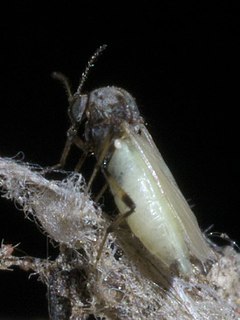 W
WBezzia nobilis is a species of biting midges in the family Ceratopogonidae. It is widely considered one of the most common Bezzia species; it is found in Eurasian regions, all over the United States, Central America, and even into South American countries like Brazil. B. nobilis seem to prefer aquatic environments; they are commonly observed in stagnant water pools in Eurasia regions and marshes in the southern United States. Adults of this species are easily distinguished by their black and yellow striped legs. Pupae are recognized by their brown bodies, abdominal spines, and respiratory horns. B. nobilis larvae are distinguished by brown heads and white bodies. Little information is known on their life cycle or mating habits. B. nobilis is a predatory species. While some research suggests they mainly feed on larvae of other insect species, experiments suggest they prefer immobile, easy prey such as dead adult flies, bacteria, and protozoa.
 W
WThe black-bellied hornet is a species of hornet native to Taiwan. It is one of the most dangerous species of hornet on the island, and its venom induces edema. Colonies may have as many as 5,000 individual hornets.
 W
WBombus eximius is a species of bumblebee that belongs to the subgenus Melanobombus in the simplified subgeneric classification. It is found in the Southern, Eastern and Southeastern parts of the Asian continent.
 W
WBombus flavidus is a species of cuckoo bumblebee found in Austria, Finland, France, Germany, Italy, Poland, Slovenia, Spain, and Switzerland.
 W
WBothynotus pilosus is a Palearctic species of true bug.
 W
WChlorochroa pinicola is a European species of shield bug in the tribe Nezarini.
 W
WThe northern colletes is a species of bee within the genus Colletes. Northern colletes are solitary bees, though females may nest in what are termed aggregations – sites where the bees nest close together, but do not form colonies as social bees do. They nest underground in soft soil, digging burrows up to 20 times their body length. It is often to be found nesting in coastal sand dunes and, on Hebridean islands, machair.
 W
WDelta bicinctum is a species of potter wasp from Australia.
 W
WDelta dimidiatipenne is a species of Potter wasp from the warmer regions of the Palearctic which specialises in the hunting of caterpillars and is therefore sometimes known as the caterpillar hunting wasp. Another name it is known by is the red potter wasp.
 W
WDelta lepeleterii is a species of potter wasp from Angola, Botswana, Burkina Faso, Democratic Republic of Congo, Eritrea, Ethiopia, Kenya, Mali, Mozambique, Namibia, Niger, Nigeria, Senegal, Socotra, Somalia, South Africa, Sudan, Tanzania.
 W
WDicyphus constrictus is a Palearctic species of true bug
 W
WEumenes dubius is a species of potter wasp in the subfamily Eumeninae of the family Vespidae.
 W
WHylaeus brevicornis is a Palearctic species of solitary bee.
 W
WHylaeus communis is a Palearctic species of solitary bee.
 W
WHylaeus confusus is a Palearctic species of solitary bee.
 W
WOncopeltus fasciatus, known as the large milkweed bug, is a medium-sized hemipteran of the family Lygaeidae. It is distributed throughout North America. It ranges from Central America through Mexico and the Caribbean to southern areas in Canada. Costa Rica represents this insect's southern limit. It inhabits disturbed areas, roadsides and open pastures. Due to this widespread geographic distribution, this insect exhibits varying life history trade-offs depending on the population location, including differences in wing length and other traits based on location.
 W
WLeptoglossus zonatus is a species of leaf-footed bug, a type of true bugs. It is found throughout much of South America, Central America, Mexico, and the southwestern United States. The bug is two centimeters in length, gray in color, with a zigzagging whitish band across its back and two distinctive yellowish spots on its anterior pronotum, the identifying characteristic for the species.
 W
WMagicicada cassinii, sometimes called the 17-year cicada, Cassin's periodical cicada or the dwarf periodical cicada, is a species of periodical cicada. It is endemic to North America. It has a 17-year lifecycle but is otherwise indistinguishable from the 13-year periodical cicada Magicicada tredecassini. The two species are usually discussed together as "cassini periodical cicadas" or "cassini-type periodical cicadas." Unlike other periodical cicadas, cassini-type males may synchronize their courting behavior so that tens of thousands of males sing and fly in unison. The specific name cassinii was in honour of John Cassin, an American ornithologist.
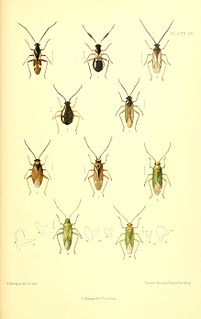 W
WMecomma dispar is a Palearctic species of true bug
 W
WMelacoryphus lateralis is a species of true bug, one of several called black-and-red seed bug. Black and fringed with red and gray, some call it the charcoal seed bug, due to its resemblance to a dying ember. Native to the deserts of western North American, they have a tendency to appear in large numbers in the late summer.
 W
WThe Mormon cricket is a large insect that can grow to almost 8 cm in length. It lives throughout western North America in rangelands dominated by sagebrush and forbs. Despite its name, the Mormon cricket is actually a shieldbacked katydid, not a cricket. It takes its name from Mormon settlers in Utah, who encountered them while pushing westward, and for the prominent role they play in the miracle of the gulls.
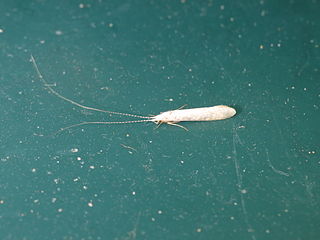 W
WNectopsyche albida is a species of long-horned caddisfly in the family Leptoceridae. It is found in North America.
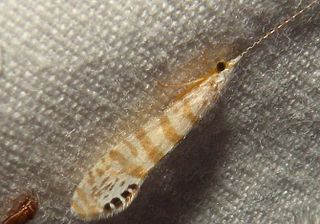 W
WNectopsyche exquisita is a species of long-horned caddisfly in the family Leptoceridae. It is found in North America.
 W
WThe northern colletes is a species of bee within the genus Colletes. Northern colletes are solitary bees, though females may nest in what are termed aggregations – sites where the bees nest close together, but do not form colonies as social bees do. They nest underground in soft soil, digging burrows up to 20 times their body length. It is often to be found nesting in coastal sand dunes and, on Hebridean islands, machair.
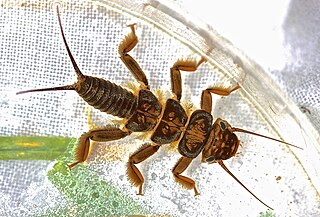 W
WParagnetina media, the embossed stonefly, is a species of common stonefly in the family Perlidae. It is found in North America.
 W
WParischnogaster mellyi is a medium-sized species of a hover wasp in the family Vespidae. It is found in Southeast Asia and is widely spread in Thailand and Malaysia. Its nests feature flexible and dynamic qualities, and they are commonly seen under roofs of houses and huts in rural areas. Hovering and patrolling behaviors are the species’ main defining behavioral features, and such activities are closely linked to its mating patterns.
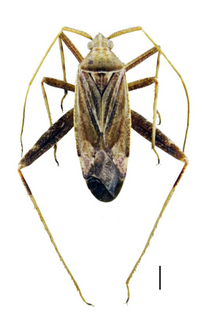 W
WPhytocoris varipes is a species of plant bugs belonging to the family Miridae, subfamily Mirinae.
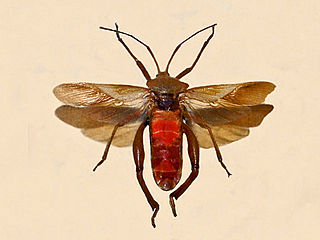 W
WPlectropoda cruciata is a species of squash bugs belonging to the family Coreidae.
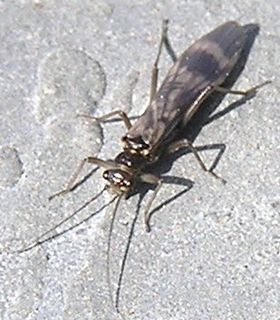 W
WProstoia completa, the central forestfly, is a species of spring stonefly in the family Nemouridae. It is found in North America.
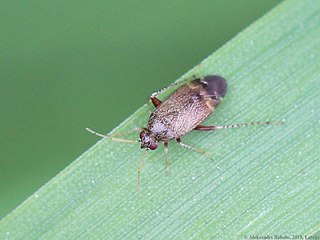 W
WPsallus perrisi is a Palearctic species of true bug
 W
WPseudopachybrachius basalis is a species of dirt-colored seed bug in the family Rhyparochromidae. It is found in the Caribbean Sea, Central America, and North America.
 W
WPtilostomis ocellifera is a species of giant casemaker in the family Phryganeidae. It is found in North America.
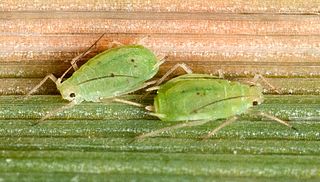 W
WSchizaphis is a genus of aphid in the family Aphididae superfamily Aphidoidea, order Hemiptera. Its original distribution is the Palaearctic, but some species have been introduced to other parts of the world.There are about 40 recognized Schizaphis species worldwide.
 W
WThe greenbug, or wheat aphid, is an aphid in the superfamily Aphidoidea in the order Hemiptera. It is a true bug and feeds on the leaves of Gramineae (grass) family members.
 W
WStagonomus is a genus of shieldbug belonging to the family Pentatomidae, subfamily Pentatominae.
 W
WStrongylognathus testaceus is a species of slave-making ant in the subfamily Myrmicinae. The species is known from Europe and the Caucasus.
 W
WSyneches simplex is a species of hybotid dance fly in the family Hybotidae.
 W
WTetramorium atratulum is a rare workerless socially parasitic ant from the Palaearctic region, which has even been introduced together with its host in North America. This extreme inquiline is represented only by female and pupoid type male individuals, whose morphology and anatomy indicate a highly specialized level of parasitism. The body of males is depigmentated, the cuticle is thin, the petiole and postpetiole are widely connected, and degenerate mandibles, palps, and antennae are observed. Female wing venation is reduced and the occipital region is narrowed. Mature females are typically physogastric and found in queenless host nests.
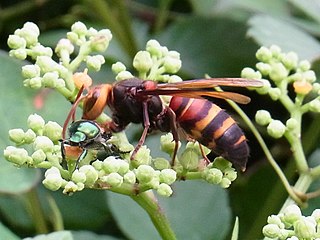 W
WVespa ducalis, the black-tailed hornet, is a hornet and an insect in the genus Vespa. It was described by Smith in 1852. In Japan, it is called himesuzumebachi
 W
WXanthippus corallipes, the red-shanked grasshopper, is a species of band-winged grasshopper in the family Acrididae. It is found in Central America and North America.
 W
WXylocopa appendiculata is a species of carpenter bee in the family Apidae.
 W
WZicca taeniola is a species of leaf-footed bug in the family Coreidae. It is found in the Caribbean Sea, Central America, North America, South America, and the Caribbean.